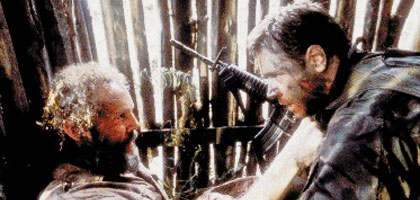
Proof of Life
USA/UK 2000

Reviewed by Geoffrey Macnab
Synopsis
Our synopses give away the plot in full, including surprise twists.
American engineer Peter Bowman is kidnapped by guerrillas in Tecala, a volatile Latin American country. Terry Thorne, a kidnap and ransom expert, flies out from Britain to conduct negotiations and ensure Peter's safe return. When he learns that Peter's company is not properly insured, he has to quit the job.
Back in Britain, Thorne, an Australian-born ex-SAS officer, is stricken with remorse. If only for the sake of Peter's wife Alice, to whom he is attracted, he returns to Tecala and offers her his services. Alice dismisses the local security expert she had hired, then Thorne attempts to barter down the hostages to a price Alice and her relatives can afford. Unknown to Thorne, Peter has made an escape attempt. He is recaptured, but a fellow hostage, German missionary Eric Kessler, escapes. He has a hand-drawn map with details of where Peter is held.
Negotiations for Peter's release stall. Thorne and his fellow kidnap-and-ransom expert Dino (who knows an Italian businessman is being held in the same place) decide to mount a rescue expedition. Just before setting off, Thorne and Alice kiss. Thanks to an elaborate decoy, most of the terrorists have been lured out of their camp. After a gun battle which leaves several of the remaining captors dead, Peter and the Italian are freed. Thorne and the team return to base. Peter is re-united with Alice. Thorne instructs them to leave the country. As they depart, Thorne and Dino talk about going into business together.
Review
Inspired by a Vanity Fair article about "the ransom trade" and by Long March to Freedom, Tom Hargrove's book about his kidnapping by FARC guerrillas in Colombia, Proof of Life suffers from a severe identity crisis. Director Taylor Hackford seems uncertain whether he is making an action adventure about mercenaries, a romantic melodrama, or a Costa-Gravas-style docu-drama about a westerner missing in Central America. The film begins spectacularly enough, with "kidnap and ransom" expert Terry Thorne, played by Russell Crowe, defying Chechen militia and Russian soldiers to rescue a kidnapped businessman. Shot in the same grey, desaturated fashion as the opening battle in Gladiator, the sequence suggests that Crowe is once again playing an action hero, having swapped swords and breast-plates for guns and grenades.
This overture belies what follows. As the scene shifts to Central America, where US engineer Peter Bowman has just been taken hostage, the film assumes an unlikely solemnity. The kidnap comes just as Bowman's marriage, to Meg Ryan's Alice, is under severe strain, and the boy's own heroics of the opening scene are briefly forgotten as Hackford attempts to explore the cracks in the relationship. His treatment of the guerrillas who kidnap Bowman is relatively even-handed, too - they're agitating for land reform. The real villains, it is implied, are the American oil corporations, destroying the country in pursuit of profit. The grainy, vérité-style camerawork and earnest performances reinforce the sense that Hackford is taking his subject matter seriously.
But ultimately he is beholden to his two stars. What really matters here is not the missing American or the drug trade, but the dynamics between Ryan and Crowe. Both play characters who sublimate their feelings for one another: Ryan curbs her instinct for comedy, while Crowe, sent to Latin America to get Alice's husband back, not to replace him, displays a stiff-upper-lipped selflessness rarely seen since Brief Encounter (1945).
The most dispiriting aspect of Proof of Life is its creeping jingoism. The film might be set in a fictional country, but that hardly excuses its stereotypical portrait of South America. Most of the locals are depicted in a resolutely negative light: there is the corrupt security expert, the oleaginous politician, the sadistic peasant who hates his hostage. Hackford throws in a few corrupt Texan businessmen to counter-balance the slimy locals, but this seems like tokenism. The engineer's life may be sacred; those of his captors are clearly not. As if tiring of the negotiation process, Hackford throws in a wham-bang finale in which Thorne, an ex-SAS man, and his old buddy fly into the jungle, guns blazing, and kill countless guerrillas. You half suspect that the escapade is Thorne's way of venting his frustration at not getting any further with Alice.
As the final credits begin to roll, to one of Van Morrison's more maudlin ballads, Alice and Peter are hot-footing their way out of Tecala, while Thorne is planning his future as a mercenary for hire. It's a glib ending to a film which falls down as a love story (the affair between Thorne and Alice is arrested before it begins), as a Wild Geese-style boy's own adventure (the action sequences are fleeting) and most of all as a piece of reportage.
Credits
- Director
- Taylor Hackford
- Producers
- Taylor Hackford
- Charles Mulvehill
- Screenplay
- Tony Gilroy
- Inspired by the Vanity Fair article 'Adventures in the Ransom Trade' by William Prochnau and by the book Long March to Freedom by Thomas Hargrove
- Director of Photography
- Slawomir Idziak
- Editors
- John Smith
- Sheldon Kahn
- Production Designer
- Bruno Rubeo
- Music/Music Producer
- Danny Elfman
